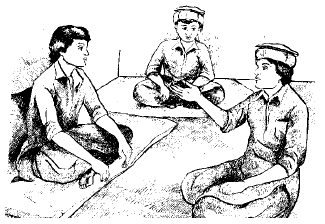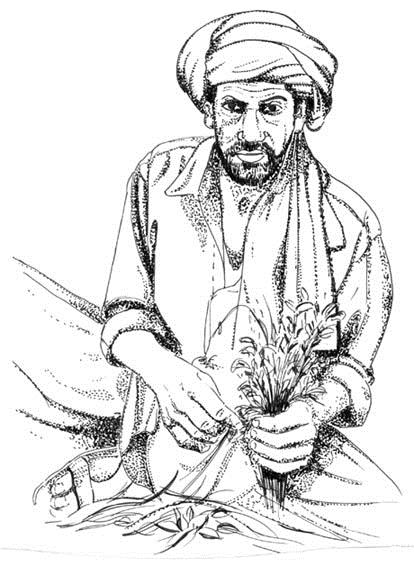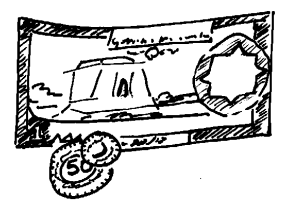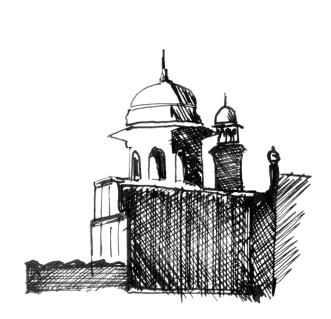Lesson Four
Dialogue four: A learner’s role
L: zu pukhto zda kawul ghwaaRum. I want to learn Pukhto. | زهٔ پښتو زده کول غواړم. |
H: Der khu, yaar. Very good, friend. | ډېر ښهٔ، یار. |
L: ásul ke zmaa pukhtaanú Der khwakh dee. Actually I like Pukhtuns a lot. | اصل کښې زما پښتانۀ ډېر خوښ دى. |
L: kho pukhto Dera gráana da. But Pukhto is very difficult. | خو پښتو ډېره ګرانه ده. |
L: zu rozaana yo dwa nuwee Tikee zda kawum. I learn a few new words every day. | زۀ روزانه يو دوه نوى ټکى زده کوم. |
H: kha! daana daana che yo zaay shee ghur shee. Good! A speck on a speck makes a mountain. | ښه! دانه دانه چې يو ځائ شى غر شى. |
L: bilkUl! zu dălta byaa raatlul ghwaaRum. Exactly! I want to come back here again. | بالکل! زهٔ دلته بیا راتلل غواړم. |
H: hăr kăla raasha. pu múkha de khu! Come anytime. May you face good! | هر کله راشه. په مخه دې ښه! |
L: du khUdaay pu aamáan! May you be found in God's peace! | د خُدای په آمان! |

Pronunciation Drill
Contrasting ټ - T and ت - t
daa Taal day. This is a swing. دا ټال دے. daa taar day. This is a thread. دا تار دے. dágha Tol sho. That has rolled-up. دغه ټول شو. dágha tor day. That is black. دغه تور دے. Top jump ټوپ top cannon توپ Contrasting oo - و and o - و
daa tóora da This is a sword دا تُوره ده. daa tóra da. This is black. دا توره ده. haghá zmaa loor da. That is my daughter. هغه زما لُور ده. hagha zmaa lor day. That is my sickle. هغه زما لور دے. daa toot day. this is a mulberry. دا تُوت دے. daa tod day. This is warm. دا تود دے.
Plural sentences
| Demonstrative adjective | Noun | Adjective | Verb | ||
|---|---|---|---|---|---|
daa | kitaabóona | khu | dee. | These books are good. دا کتابونه ښهٔ دی. | |
daa | aaloogáan | kharáab | dee. | These potatoes are bad. دا آلوګان خراب دی. | |
dágha | qalumóona | narée | dee | dágha qalumóona naree dee. دغه قلمُونه نری دی. | |
dágha | mungukáan | shaytaanáan | dee. | These mice are bothersome. دغه منږکان شېطانان دی. | |
hágha | waróona | speen | dee. | Those doors are white. هغه ورونه سپین دی. | |
hágha | ookháan | ghaT | dee. | Those camels are big. هغه اُوښان غټ دی. | |
NOTE:
شېطان - shetáan (the devil) is also an adjective meaning 'naughty' or 'troublesome'.
Making masculine nouns plural
Inanimate nouns ending in a consonant are inflected to ـونه - --oona
| daa looy kor day. | This is a big house. | دا لوی کور دے. |
| daa looy koróona dee. | These are big housese. | دا لوی کورونه دی. |
ے - ay endings become ی - ee
| staa spay waRóokay day. | Your dog is small. | ستا سپے وړُوکے دے. |
| staa spee waaRu dee. | Your dogs are small. | ستا سپی واړهٔ دی. |
Animate nouns ending in a consonant are changed to ان - aan
| hágha maar lunD day. | That snake is short. | هغه مار لنډ دے. |
| hágha maaraan lunDee dee. | Those snakes are short. | هغه ماران لنډی دی. |
| dágha khatarnáak laRúm day. | That is a dangerous scorpion. | دغه خطرناک لړم دے. |
| dágha khatarnáak laRumaanaan dee. | Those are dangerous scorpions. | دغه خطرناک لړمانان دی. |
NOTE:
Notice how the adjective لنډ - lunD rhymes with the verb by adding ی - ee to become لنډی - lunDee. This type of agreement is like Cockney rhyming slang and is best learned by mimicry rather than by following rules.
Inanimate nouns ending in و - oo are changed to ګان - gaan or وان - waan
| daa aaloo muzedaar day. | This potatoe is delicious. | دا آلُو مزېدار دے. |
| daa aaloogáan muzedaar dee. | These potatoes are tasty. | دا آلوګان مزېدار دی. |
| hágha kadóo kharáab day. | That squash is rotten. | هغه کدُو خراب دے. |
| hágha kadwáan kharáab dee. | Those squash (squashes) are rotten. | هغه کدوان خراب دی. |
An exercise in making masculine nouns plural
👆 Have your helper make simple singular sentences with the following nouns. Then try to make them plural.
| maashóom | child | ماشُوم |
| saRay | man | سړے |
| lúkhta | stick | لښته |
| gUl | flower | ګُل |
| bistúra | mattress | بِستره |
| gáaDay | vehicle | ګاډے |
| much | fly | مچ |
| máashay | mosquito | ماشے |
| kúlay | village | کلے |
| baagh | garden | باغ |
| qalúm | pen | قلم |
| maalée | gardener | مالی |
| gúDa | sheep | ګډه |

Subject markers for verbs
| Person | Singular | Person | Plural |
|---|---|---|---|
I | --im ـم | we | --oo ـو |
you | --e ـې | you (plural & for respect) | --ey ـئ |
he, she, it | --ee ـي | they | --ee ـي |
NOTES:
The second person singular pronoun تهٔ - tu and the second person singular subject marker ې - e are used in informal conversation. تهٔ - tu is the normal pronoun used to speak to family, friends and children. It is also used in everyday conversation outside the house.
The second person plural form تاسو - taaso and the second person plural subject marker ئ - ey are used to address people with extra politeness. For example, تاسو - taaso might be used when talking to a respected leader or elder. Note, although تاسو - taaso is plural in form, it can be used to address one person. The nearest English equivalent is the royal 'we’.
Asking Questions
Who? څوک؟ - tsok?
| zmaa noom _______ day. | My name is _______. | زما نوم ______ دے. |
| haghá tsok day? | Who is he? | هغه څوک دے؟ |
| yo mushahóor Ustáaz day. | A famous teacher. | یو مشهور اُستاذ دے. |
It is common to drop the subject out of the sentence in colloquial speech. For example you will often hear sentences like: پښتُون یم - pukhtoon yim (I am a Pukhtoon), rather that the more formal زهٔ پښتُون یم. - zu pukhtóon yim. Therefore, it becomes important to recognise and use the subject markers – the only clue as to who the speaker is talking about:
How many? How much? څو؟، څومره؟ - tso?, tsoomra?
| tso kasáan dee? | How many people are there? | څو کسان دی؟ |
| tsóomra aabaadée da? | What is the population? | څومره آبادی ده؟ |
| taaso tsoomra wrooNa yey? | How many brothers are you? | تاسو څومره ورُوڼه یئ؟ |
With whom? چا سره؟ - chaa sara?
| khu qalúm chaa sara day? | Who has a good pen? | ښهٔ قلم چا سره دے. |
| khu qalúm maa sara day. | I have a good pen. | ښهٔ قلم ما سره دے. |
| Dere payse chaa sara dee? | Who has a lot of money? | ډېرې پیسې چا سره دی؟ |
| heechaa sara nishta. | No one has any. | هیچا سره نشته. |
Where? چرته؟ - chărta?
| shaahid chărta day? | Where is Shahid? | شاهد چرته دے؟ |
Postpositions
The preposition په - pu (in) is often followed by a noun and another preposition to form a 'split' prepositional phrase, which is translated as a single preposition in English. The sentences below illustrate how a noun can be sandwiched between two prepositions. The preposition which follows the noun is called a postposition. The words باندې - baande (above) and لاندې - laande (below) are examples of postpositions in Pukhto.
“in” په ___ کښې - pu ____ ke
| staa wroor chărta day? | Where is your brother? | ستا ورور چرته دے؟ |
| hagha pu khaar ke day. | He is in the city. | هغه په ښار کښې دے. |
| hagha pu kor ke day. | He is in the house. | هغه په کور کښې دے. |
| tsok pu klaas ke day? (or) pu klaas ke tsok dee? | Who is in the classroom? | څوک په کلاس کښې دے؟ (یا) په کلاس کښې څوک دي؟ |
| Ustáaz pu klaas ke day. | The teacher is in the classroom. | اُستاذ په کلاس کښې دے. |
“on” په ____ باندې - pu _____ baande
| qalúm pu baks ke day? | Is the pen in the suitcase? | قلم په بکس کښې دے؟ |
| na, pu bakus baande day. | No, it is on the suitcase. | نه، په بکس باندې دے. |
| nisáar pu chut baanday day? | Is Nisar on the roof? | نثار په چت باندې دے؟ |
| na, pu kamrá kkhe day. | No, he is in the room. | نه، په کمره کښې دے. |
NOTE:
Again, colloquial speech is often shortened. The common expression چائې باندې دی - chaay baande dee meaning 'The tea is on', may be a contraction of چائې په چوله باندې دی - chaar pu chola baande dee (The tea is on the stove).
“under” د ____ لاندې - du ____ laande
| pinsúl chărta day? | Where is the pencil? | پِنسل چرته دے؟ |
| pinsul du mez laande day. | The pencil is under the table. | پِنسل د مېز لاندې دے. |
👆 With the help of your teacher, use the above drill to ask the location of different objects that are at hand. Remember to make use of objects you already know the name of so that you are not learning names and postpositions at the same time.
Some parts of the body
👆 Ask your helper to drill you in the names for these parts of the body. Respond to the words by touching the appropriate parts.

Working with money
👆 Collect a variety of notes and coins and practice using it with your helper, by taking turns asking and giving various amounts.
| shpug roopúy ráaka! | Give me six rupees! | شپږ روپۍ راکه! |

Memorising Moment
متلونه - matulóona
Exercises for lesson Four
- Using the question دا څه شے دے؟ - daa tsu shay day? (What is this?), point and reply to the following parts of the body:
- Make the following sentences plural:
- Fill in the correct plural suffix in each sentence.
Substitute the following pairs of words for the underlined words in the sentence:
Ustaazáan pu skool ke dee. اُستاذان په سکول کښې دی.
Use the words listed below to transform the following sentence:
haghá DakTúr day. هغه ډاکټر دے.
